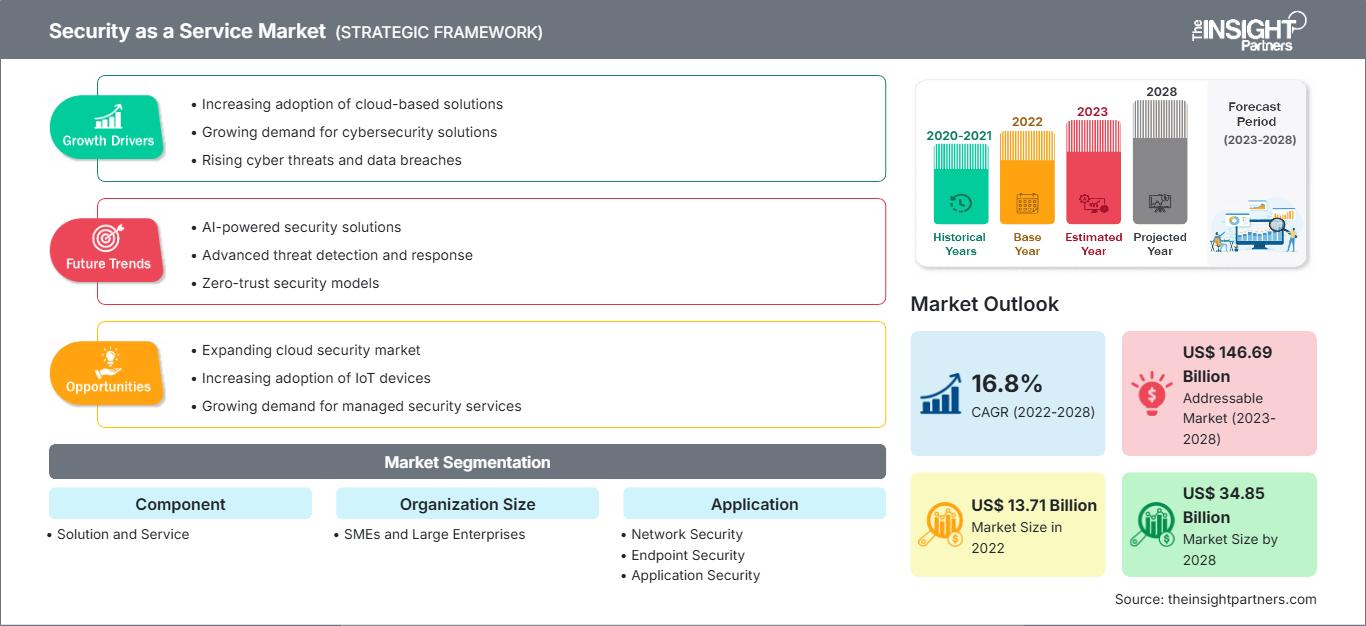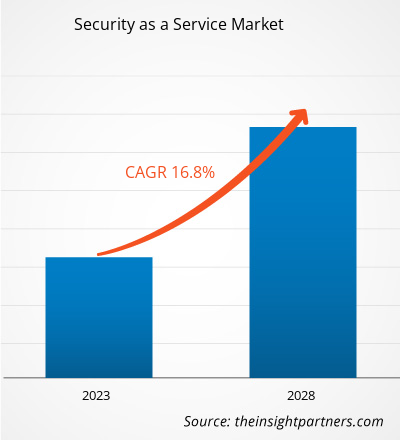Se prevé que el mercado de seguridad como servicio alcance los 34.854,10 millones de dólares estadounidenses en 2028, frente a los 13.712,87 millones de dólares estadounidenses en 2022. Se espera que crezca a una tasa de crecimiento anual compuesta (TCAC) del 16,8% entre 2022 y 2028.
La seguridad como servicio (SaaS) es una técnica que proporciona soluciones de seguridad a las organizaciones para sus centros de datos o puertas de enlace regionales. Al facilitar el acceso seguro a las aplicaciones, se ha convertido en un enfoque crucial para que las empresas aumenten sus implementaciones móviles y en la nube. Para mejorar la seguridad de las aplicaciones empresariales, se implementan diversas soluciones de seguridad. La prevención de pérdida de datos (DLP), las soluciones de cumplimiento normativo, la prevención avanzada de malware, los agentes de seguridad de acceso a la nube (CASB) que toman decisiones y la monitorización continua son solo algunas de las soluciones de seguridad que se ofrecen. Los proveedores de servicios cobran a las organizaciones una tarifa mensual razonable por sus servicios. Gracias a estas ventajas, las industrias usuarias finales recurren cada vez más a los proveedores de servicios, lo que se prevé que impulse la expansión global del mercado de SaaS. Las organizaciones utilizan ampliamente la seguridad como servicio porque ofrece numerosas ventajas con respecto a los enfoques tradicionales, como operaciones más rápidas, actualizaciones antivirus constantes, soluciones rentables y mayor agilidad operativa.
La demanda global de soluciones de seguridad también está creciendo debido a la creciente digitalización y el uso de servicios en la nube en diversos sectores. Muchas empresas han adoptado recientemente aplicaciones empresariales, políticas de "trae tu propio dispositivo" (BYOD), la tendencia de "elige tu propio dispositivo" (CYOD) y otras tecnologías. La preocupación por la integridad y la confidencialidad de los datos organizacionales ha aumentado debido a estas tendencias. Más de 3700 millones de personas usan el correo electrónico en todo el mundo, y se envían 269 000 millones de correos electrónicos diariamente como resultado del desarrollo de los métodos de marketing electrónico. Esto ofrece grandes oportunidades para que los hackers envíen correos no deseados a los usuarios para obtener información crucial sobre ellos. La mayoría de los problemas de seguridad comienzan con correos electrónicos de phishing, utilizados por los hackers para engañar a las víctimas y obtener acceso a cuentas, credenciales o información financiera antes de realizar ataques técnicos. Por lo tanto, la creciente importancia de la ciberseguridad impulsa fuertemente el crecimiento del mercado de la seguridad como servicio.
Obtendrá personalización gratuita de cualquier informe, incluyendo partes de este informe, análisis a nivel de país y paquetes de datos de Excel. Además, podrá aprovechar excelentes ofertas y descuentos para empresas emergentes y universidades.
Mercado de seguridad como servicio: Perspectivas estratégicas

- Obtenga las principales tendencias clave del mercado que se describen en este informe.Esta muestra GRATUITA incluirá análisis de datos, que abarcarán desde tendencias de mercado hasta estimaciones y pronósticos.
Impacto de la pandemia de COVID-19 en el crecimiento del mercado de seguridad como servicio
El continuo aumento en el número de pacientes infectados con el nuevo coronavirus obligó a las autoridades gubernamentales a imponer confinamientos estrictos en Estados Unidos y otras regiones durante los primeros tres trimestres de 2020. El sector manufacturero sufrió graves pérdidas debido al cierre temporal de fábricas, mientras que la mayoría de las empresas se vieron obligadas a adoptar el teletrabajo. El auge del trabajo desde casa provocó un aumento de los ciberataques y, por consiguiente, de la necesidad de protección. Las pequeñas y medianas empresas se vieron obligadas a incrementar su inversión en soluciones de seguridad de red. Como consecuencia de estos efectos de la pandemia, el mercado de seguridad como servicio se vio beneficiado. En Estados Unidos, se observó un fuerte incremento en el phishing y la distribución de malware mediante señuelos relacionados con la COVID-19, así como en el registro de nuevos nombres de dominio con términos relacionados con el coronavirus o la COVID-19.
La región también experimentó un aumento en las transacciones en línea, lo que atrajo aún más a los ciberdelincuentes. Por consiguiente, las empresas comenzaron a centrarse en la infraestructura de ciberseguridad para proteger a sus clientes y empleados. Esto generó grandes oportunidades de crecimiento para los participantes del mercado. Microsoft informó que, entre febrero y mayo de 2020, se detectaron 19 millones de ataques de phishing y ransomware con temática de COVID-19 en la región Asia-Pacífico. Dado que muchas personas se vieron obligadas a trabajar desde entornos menos seguros creados apresuradamente durante la pandemia, el creciente uso de servicios en la nube se convirtió en un foco de ciberataques. Por lo tanto, la COVID-19 influyó positivamente en el crecimiento del mercado global de seguridad como servicio.
Perspectivas del mercado: Mercado de seguridad como servicio
El auge del comercio electrónico, la creciente concienciación sobre la protección de datos, la tendencia del uso de dispositivos personales (BYOD) y la aceptación de medidas de seguridad gestionadas generan importantes perspectivas de mercado. El uso de tecnologías en la nube ha crecido significativamente, lo que ha incrementado la demanda de soluciones de seguridad más fiables y asequibles. La infraestructura de TI se ha vuelto más compleja y heterogénea en los últimos cinco años debido a la introducción de nuevas plataformas, normativas BYOD, la tendencia del uso de dispositivos personales en el trabajo (CYOD), aplicaciones empresariales y otras tecnologías. Las tendencias BYOD y CYOD son cada vez más comunes en el ámbito empresarial gracias a las rápidas mejoras en la informática móvil. Las organizaciones contratan servicios de seguridad para proteger dispositivos como smartphones, tabletas, ordenadores de sobremesa y portátiles de los ciberataques derivados de la adopción del modelo BYOD. Estas tendencias impulsan intrínsecamente el mercado de la seguridad como servicio.
Perspectivas basadas en el tamaño de la organización
El mercado de seguridad como servicio, segmentado por tamaño de organización, se divide en grandes empresas y pymes (pequeñas y medianas empresas). Se prevé que el segmento de pymes registre una mayor tasa de crecimiento anual compuesto (TCAC) durante el período de pronóstico. Según el Banco Mundial, las pymes contribuyen con aproximadamente el 40 % del PIB y el 60 % del empleo total en las economías emergentes. Con el creciente número de pymes enfocadas en simplificar sus operaciones y reducir sus costos operativos, los actores del mercado de seguridad como servicio están experimentando una demanda significativa de soluciones de seguridad por parte de este segmento. A medida que la digitalización abre nuevas oportunidades para las pymes, se pronostica una mayor tasa de crecimiento para este segmento en el mercado de seguridad como servicio.
El mercado de seguridad como servicio se analiza en función del componente, el tamaño de la organización, la aplicación y el sector vertical. Según el componente, el mercado se divide en soluciones y servicios. Por tamaño de la organización, se segmenta en pymes y grandes empresas. Por aplicación, se segmenta en seguridad de redes, seguridad de endpoints, seguridad de aplicaciones, seguridad en la nube y otros. Según el sector vertical, se segmenta en banca, servicios financieros y seguros (BFSI), gobierno y defensa, comercio minorista, sanidad, TI y telecomunicaciones, energía y servicios públicos, manufactura y otros. Geográficamente, el mercado de seguridad como servicio se segmenta principalmente en Norteamérica, Europa, Asia Pacífico (APAC), Oriente Medio y África (MEA) y Sudamérica (SAM).
Perspectivas regionales del mercado de seguridad como servicio
Los analistas de The Insight Partners han explicado en detalle las tendencias y los factores regionales que influyen en el mercado de Seguridad como Servicio durante el período de previsión. Esta sección también analiza los segmentos y la geografía del mercado de Seguridad como Servicio en Norteamérica, Europa, Asia Pacífico, Oriente Medio y África, y Sudamérica y Centroamérica.
Alcance del informe de mercado sobre seguridad como servicio
| Atributo del informe | Detalles |
|---|---|
| Tamaño del mercado en 2022 | 13.710 millones de dólares estadounidenses |
| Tamaño del mercado para 2028 | 34.850 millones de dólares estadounidenses |
| Tasa de crecimiento anual compuesto global (2022 - 2028) | 16,8% |
| Datos históricos | 2020-2021 |
| período de previsión | 2023-2028 |
| Segmentos cubiertos | Por componente
|
| Regiones y países cubiertos | América del norte
|
| Líderes del mercado y perfiles de empresas clave |
|
Densidad de los actores del mercado de seguridad como servicio: comprensión de su impacto en la dinámica empresarial
El mercado de seguridad como servicio está creciendo rápidamente, impulsado por la creciente demanda de los usuarios finales debido a factores como la evolución de las preferencias de los consumidores, los avances tecnológicos y una mayor conciencia de los beneficios del producto. A medida que aumenta la demanda, las empresas amplían su oferta, innovan para satisfacer las necesidades de los consumidores y aprovechan las tendencias emergentes, lo que impulsa aún más el crecimiento del mercado.

- Obtenga una visión general de los principales actores del mercado de seguridad como servicio.
Alert Logic, Inc., Barracuda Networks, Inc., IBM Corporation, McAfee LLC, Microsoft Corporation, Radware, Trend Micro Incorporated, Clearswift, Silversky, Zscaler, Inc. son los principales actores del mercado de Seguridad como Servicio.
Los participantes del mercado se están centrando en las fusiones y adquisiciones. A continuación, presentamos un resumen de los últimos acontecimientos en el mercado de Seguridad como Servicio:
- En 2022, HelpSystems anunció sus planes para adquirir Alert Logic con el fin de proporcionar a sus clientes un enfoque de TI híbrido para abordar la escasez de profesionales cualificados en ciberseguridad.
- En 2022, IBM Corporation anunció sus planes para adquirir Randori, proveedor de protección cibernética ofensiva y gestión de la superficie de ataque. Según ITPro, IBM pretende integrar el software de Randori con las funciones de detección y respuesta extendidas (XDR) de IBM Security QRadar.
- Análisis histórico (2 años), año base, pronóstico (7 años) con CAGR
- Análisis PEST y FODA
- Tamaño del mercado, valor/volumen: global, regional y nacional
- Industria y panorama competitivo
- Conjunto de datos de Excel
Informes recientes
Informes relacionados
Testimonios
Razón para comprar
- Toma de decisiones informada
- Comprensión de la dinámica del mercado
- Análisis competitivo
- Información sobre clientes
- Pronósticos del mercado
- Mitigación de riesgos
- Planificación estratégica
- Justificación de la inversión
- Identificación de mercados emergentes
- Mejora de las estrategias de marketing
- Impulso de la eficiencia operativa
- Alineación con las tendencias regulatorias






















 Obtenga una muestra gratuita para - Mercado de seguridad como servicio
Obtenga una muestra gratuita para - Mercado de seguridad como servicio